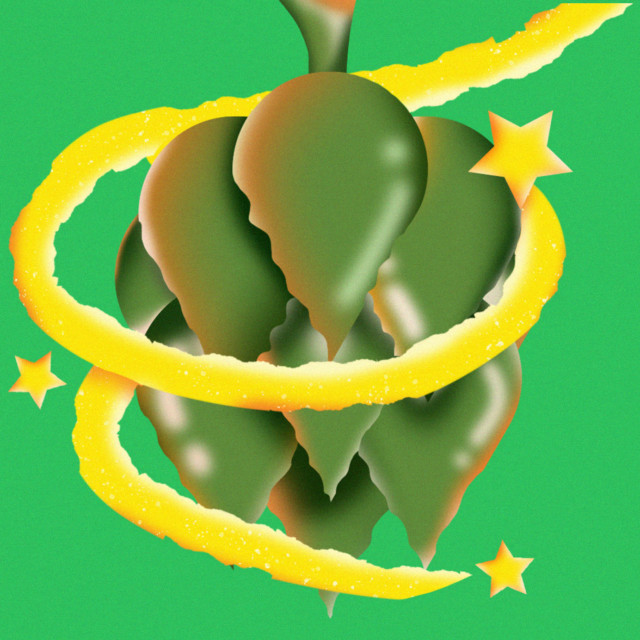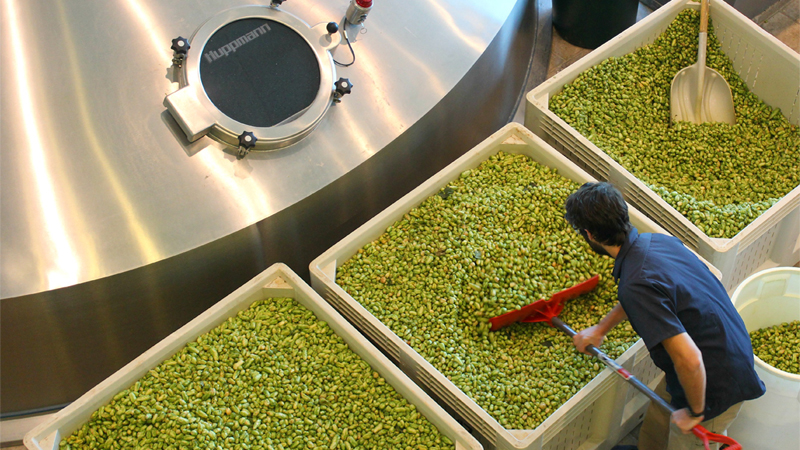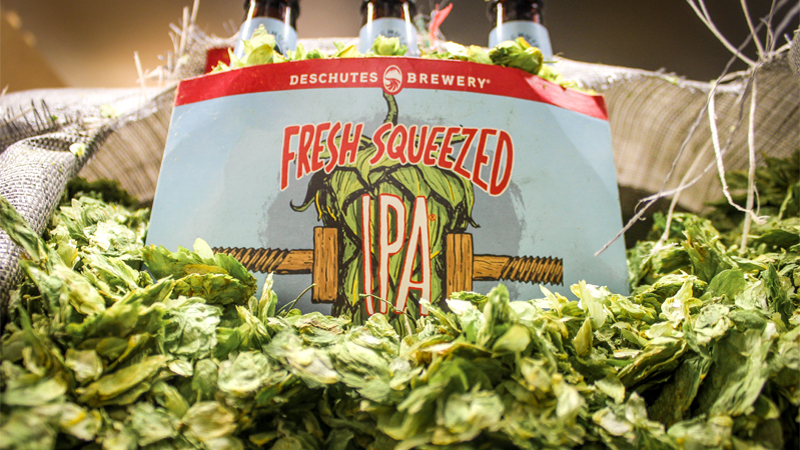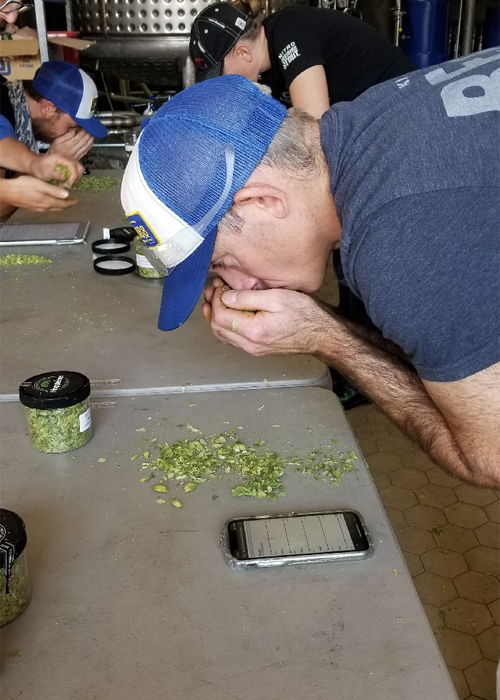In 2010, a new beer went on tap at the Fred Miller Pub, Miller Brewing’s employee bar. At face value, this wasn’t especially remarkable. The company’s sprawling Milwaukee complex includes a 10-barrel pilot brewery that regularly produces exclusives for staff and visitors in the name of research and innovation. But as an India Pale Ale with 70 IBU and a dry hopping rate of four pounds per barrel, it stood out from many of Miller’s usual offerings. And this beer had a playful and provocative name, too: Wild Ting.
“That beer was so great,” says Dr. Patrick Ting, a former hop scientist at MillerCoors, and the beer’s namesake. “It tasted like white wine to me. I also associated a mango and a lychee flavor. A lot of people liked it.”
Brewed entirely with an experimental hop variety originally known as 9148-114, this one-off IPA with a zesty citrus aroma and a tropical fruit flavor was ahead of its time. As Dr. Ting remembers it, quite a few colleagues found the taste to be too strong — some people described it as “catty.” To him though, Wild Ting IPA was something different — and different was good. After more than 30 years of researching hops for Miller and MillerCoors, he hadn’t come across anything that special.
Three or four years earlier, he’d encouraged his bosses to contract a commercial-scale test plot of the variety after evaluating it during initial brewing trials. In 2007, MillerCoors did just that, sponsoring two acres of a plant owned by the Hop Breeding Company (HBC), a partnership between two large breeding programs in Washington State. HBC referred to the experimental variety as HBC 394. Today, we call it Citra.
MillerCoors never found a use for the hop, but four other breweries that also helped to finance its development did, and their support went a long way in securing a long-term future for Citra. Widmer Brothers, Sierra Nevada, Boulevard, and Deschutes all took a risk on HBC 394, and in so doing, influenced the trajectory of both modern brewing and hop breeding. Over the past 14 years, and particularly in the last six or seven, Citra went from a trial variety to what is arguably the world’s most sought-after hop — driving today’s hazy IPA craze and consumers’ ravenous thirst for the likes of beers from Other Half, WeldWerks, Tree House, and many other breweries.
At this point Citra is hard to miss. Go ahead, try to find a top-rated, sought-after IPA that doesn’t include this kingmaker hop. It also turns up in any number of other styles from blonde ales and witbiers to farmhouse ales and even Labatt Blue (yes, you read that right). As Michael Ferguson, director of hop breeding at Haas puts it, Citra is like autotune for beer.
“Citra gets along with everybody at the IPA party,” says Steve Luke, founder and head brewer at Seattle’s Cloudburst Brewing, which has pleased the public with its boldly hoppy beers since 2016. “It can be the star, it can be a role player, sometimes you might not even know it’s in there. Its flavor impact is also incredibly predictable. There is no better hop that plays well with other American varieties. It fruitifies, melds, and cushions so many other hops.”
Luke has used Citra for more than a decade now and still waxes rhapsodic about its pleasant flavors and aromas of ripe yellow peach, tangerine, and apricot. He describes it as “clean” — lacking muddled undertones or lingering harshness — and forgiving, and says he includes Citra in roughly 80 percent of his highly regarded hop-forward beers. At the 2020 Great American Beer Festival, judges awarded Cloudburst a silver medal in the Juicy or Hazy Imperial India Pale Ale category for Not a Scientist, which is brewed with Strata, Mosaic, and, you guessed it, Citra hops.
Citra began as an innovative cross developed by Gene Probasco in 1990. Wanting to try something different, he cross-pollinated a brother and sister from the same family: Hallertauer Mittelfrueh. The resulting plants weren’t high-yielding, but he liked the shape and weight of the cones and their high lupulin content, which is valuable to brewers. Probasco, who established and led the agronomic and plant breeding program at hop supplier John I. Haas in Yakima, Wash., from 1978 until his retirement in 2016, was interested in new aroma varieties, although he couldn’t find any takers at the time. Hops in the ‘80s and ‘90s were a commodity, a vastly different reality than today’s specialty market, where public — and increasingly private — breeders have turned plants into brands marketed to thousands of breweries searching for new ingredients to give them a creative edge.
“The U.S. hop industry when I got into the business was 100 percent alpha varieties and a little bit of Fuggle,” says Probasco, referring to hops prized for their higher alpha acid levels, which make for more efficient bittering. His employer was developing hops for large brewery clients that weren’t necessarily looking for a variety with grapefruit character. They wanted consistency, and they needed quantity.
“It was just me to start with. We hardly did anything with the microbrewers at that time,” Probasco says. “I just thought [Citra] was so interesting so we just kind of kept it in the field.”
Without any serious interest from a buyer, Citra stayed in the field for more than a decade. But even after Haas merged its breeding program with Select Botanicals Group, the breeding arm of Yakima Chief Hops, to form HBC, Probasco kept a few plants in a plot he refers to as a museum — out of sight, out of mind. And then in the early aughts, Dr. Ting came calling, looking for something different.
Meanwhile, Probasco had been quietly reaching out to smaller breweries, talking up the variety at industry conferences and conventions.
“I started going to Hop Research Council meetings in 2005,” says Tom Nielsen, research and development and raw materials manager at California’s Sierra Nevada Brewing. “Gene would pull you aside super secretly and try to engage you in a collaboration. We started to experiment with it for about a year. [Haas] even gave us some rootstock — the biggest, juiciest rootstock I’ve ever seen.”
So Sierra Nevada planted Citra in its Chico hopyard and used the variety in a few beers, including its Estate Ale for a couple of years. But it was another beer brewed with Citra that really raised eyebrows. About the same time that Nielsen got his hands on HBC 394, Sierra Nevada was working on a bold, draft-only beer somewhere between an IPA and a double IPA that relied heavily on Crystal and Magnum hops. While experimenting with different dry hop combinations, and by using a new tool called a hop torpedo to capture more of the oils and resins in the leafy green cones, the brewery discovered the missing piece in its recipe.
“[Citra] brightened the beer up in a really nice way,” Nielsen remembers. “It just smacked you across the face.”
In early 2009, Sierra Nevada added Torpedo Extra IPA, dry-hopped with Citra, to its lineup. It marked the first change to the company’s year-round range since 1980, and Torpedo has remained in the mix for 12 years and counting. That same year, some 350 miles to the north, Fresh Squeezed IPA also appeared on the draft list for the first time at the Deschutes Brewery pubs in Bend and Portland, Ore. And the starring hop? Citra, once again. The brewers at Deschutes had begun producing test batches with the variety in 2006, and liked the results. When Fresh Squeezed was wildly popular with customers, too, they knew they were on to something.
“Citra is the protagonist of the Fresh Squeezed story,” says Veronica Vega, director of product development at Deschutes. “It created the beer, it inspired the name, and it became the lightning in a bottle that every brewer dreams of. On top of the unique flavors and aromas, what Citra brought to the table was impact. It walloped you in the face.”
Four years after debuting on draft, Deschutes introduced Fresh Squeezed in bottles, catapulting the beer to the top of the company’s sales ranking, where it remains today. More recently, the success of Fresh Squeezed and the increased availability of Citra has led the brewery to introduce a pale ale called Lil’ Squeezy, as well as an imperial IPA called Royal Fresh. Back in California, Sierra Nevada built on the lessons learned with Torpedo and launched Tropical Torpedo, an IPA with a lower ABV that leans into Citra’s intensely fruity character and adds several other newer hop varieties.
By 2009, growers in Washington harvested 98 acres of Citra, all of which was quickly snatched up by a handful of craft brewers. Just four years later, that number had increased to 1,296 acres, plus another 19 acres in Idaho. The word was out about this special hop, and there was no shortage of demand for Probasco’s agricultural achievement. At the same time, brewers were pushing IPA in a new direction, creating hazy, juicy beers with pillowy textures and far less bitterness than their predecessors. In 2020, the Citra harvest was approximately 19 percent of the entire combined harvested area for Washington, Oregon, and Idaho. At just shy of 11,000 acres, it now far surpasses any other variety.
“Citra is already a larger acreage share than Cascade was in 2015 both in acreage numbers and percentage of the crop,” explains Jaki Brophy, communications and marketing director for Hop Growers of America, a trade organization based in Washington’s Yakima Valley. Cascade, which had been top hop for years, fell to fifth place in 2020. “Citra is firmly in the top spot, with just over 4,700 acres difference between it and the No. 2 hop in the top 10,” Brophy adds.
Industry experts like Brophy and Ferguson at Haas predict that Citra acreage will continue to increase, though perhaps not at the dramatic rates seen a few years ago. Other new so-called flavor hops have also generated excitement in the past few years; hops like Mosaic (HBC 369), Strata, and Idaho 7. Growers harvested 5,496 acres of Mosaic last year, making it the variety with the third-largest harvest area in the U.S. And yet, as much as some brewers might want to reach for something else when designing their next recipes, Citra’s popularity shows no signs of waning, thanks in large part to its approachability.
From a variety that was collecting dust in a “hop museum” less than two decades ago, Citra has won over brewers and drinkers alike, securing its place in brewhouses and taprooms for the foreseeable future. Steve Luke at Cloudburst also believes that the soaring acreage for Citra and the ascendancy of hazy IPA go hand in hand: As he sees it, one wouldn’t exist without the other. It’s a theory at least partially borne out by Sierra Nevada’s experience coming up with Hazy Little Thing. According to Nielsen, the brewery initially tried not to use Citra in the runaway hit of an IPA that launched nationally in 2018. Ultimately it earned a place in the beer anyway.
“We went through the exercise,” Nielsen says. “But Citra is such a wonderful hop. It has everything Mosaic has and everything Simcoe has.”
A beer that leverages Citra hops for its appeal isn’t nearly as different today as it was in 2010 when the first keg of Wild Ting was tapped in Milwaukee. That doesn’t mean people like it any less. Three short years after the first 6-packs appeared on shelves nationwide, Hazy Little Thing is already Sierra Nevada’s second best-selling brand, just behind Pale Ale and one spot ahead of Torpedo Extra IPA. It would truly be a wild thing if this Citra-hopped hazy IPA were to eclipse the Pale Ale that helped build Sierra Nevada into the 10th largest brewery in the country.
Since retiring, Gene Probasco has become more of a wine drinker, and hasn’t tried Hazy Little Thing. In fact, he says he hasn’t had a beer made with Citra “in quite some time.” But Probasco fondly remembers Zombie Dust, a Pale Ale from Indiana’s Three Floyds that’s heavily hopped with the variety he developed.
“It’s one of the best beers I’ve had with Citra,” he says without hesitation. “It’s one of the better beers I’ve had.”
This story is a part of VP Pro, our free platform and newsletter for drinks industry professionals, covering wine, beer, liquor, and beyond. Sign up for VP Pro now!



